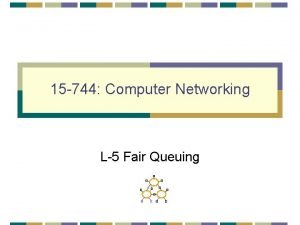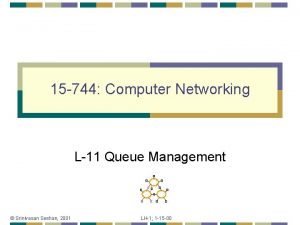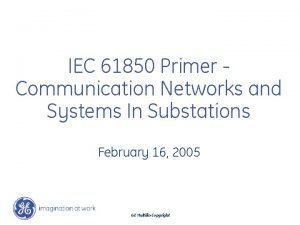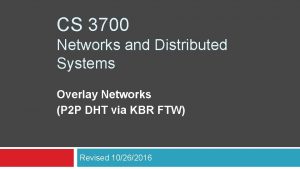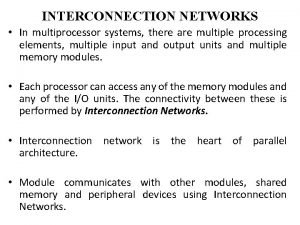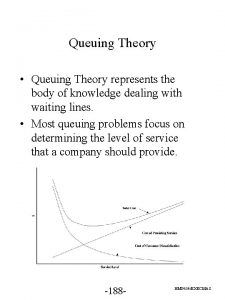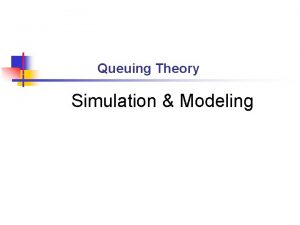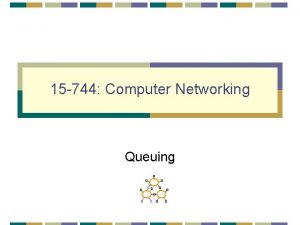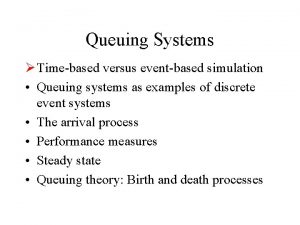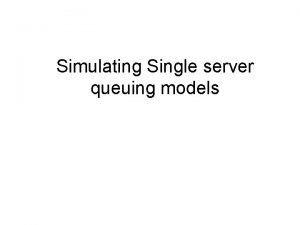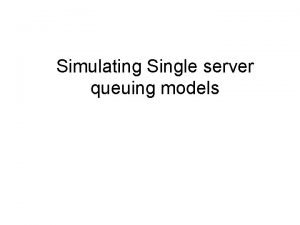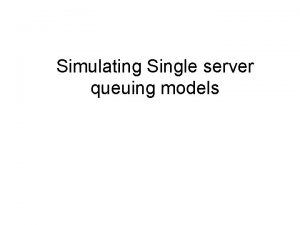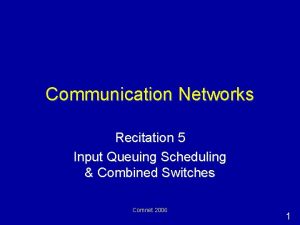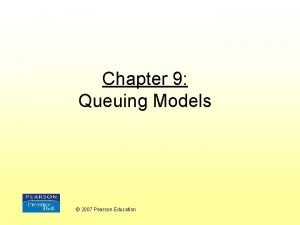Queuing Networks Structure of Single Queuing Systems Input















- Slides: 15

Queuing Networks

Structure of Single Queuing Systems Input source arriving customers Queue Service mechanism exiting customers Note: 1. Customers need not be people parts, vehicles, machines, jobs. 2. Queue might not be a physical line customers on hold, jobs waiting to be printed, planes circling airport.

Definition of queueing networks A queueing network is a system composed of several interconnected stations, each with a queue. Customers, upon the completion of their service at a station, moves to another station for additional service or leave the system according some routing rules (deterministic or probabilitic). 3

Queuing Networks In many applications, an arrival has to pass through a series of queues arranged in a network structure.

Open network or closed network Open network N customers 5 Closed network

A production line Raw parts 6 Finished parts

Jackson Network Definition 1. All outside arrivals to each queuing station in the network must follow a Poisson process. 2. All service times must be exponentially distributed. 3. All queues must have unlimited capacity. 4. When a job leaves one station, the probability that it will go to another station is independent of its past history and is independent of the location of any other job. In essence, a Jackson network is a collection of connected M/M/s queues with known parameters.

Jackson’s Theorem 1. Each node is an independent queuing system with Poisson input determined by partitioning, merging and tandem queuing example. 2. Each node can be analyzed separately using M/M/1 or M/M/s model. 3. Mean delays at each node can be added to determine mean system (network) delays.

Open Jackson Network An open Jackson network (1957) is characterized by: • • One single class of customers • • • One server at each station Exponentially distributed service time with rate mi at station i Unlimited capacity at each queue FIFO service discipline at all queues Probabilistic routing A Poisson arrival process at rate l (equivalent to independent external Poisson arrival at each station) 9

Open Jackson Network routing • pij (i ≠ 0 and j≠ 0) : probability of moving to station j after service at station i • p 0 i : probability of an arriving customer joining station i • pi 0 : probability of a customer leaving the system after service at station i 10

Open Jackson Network stability condition • Let li be the customer arrival rate at station i, for i = 1, . . . , M where M is the number of stations. • The system is stable if all stations are stable, i. e. li < mi, "i = 1, . . . , M • Consider also ei the average number of visits to station i for each arriving customer: ei = li/l 11

Open Jackson Network arrival rate at each station • 12 These arrival rates can be determine by the following system of flow balance equations which has a unique solution.

Open Jackson Network Are arrivals to stations Poisson? as the departure process of M/M/1 queue is Poisson. Feedback keeps memory. 13

Closed Queuing Network Definition • Similar to Jackson network but • with a finite population of N customers • without extern arrivals. As a result, • • • 14 l=0

Closed Queuing Network Arrival rates 15 • The arrival rates li satisfy the following flow balance equations • Unfortunately, the above system of flow balance equations has one free variable.
 Queuing discipline in computer networks
Queuing discipline in computer networks Srinivasan seshan
Srinivasan seshan Virtual circuit network
Virtual circuit network Backbone networks in computer networks
Backbone networks in computer networks Single node architecture in wsn
Single node architecture in wsn Peripheral input (perangkat input) adalah.
Peripheral input (perangkat input) adalah. Finely tuned input
Finely tuned input Iec 61850 communication networks and systems in substations
Iec 61850 communication networks and systems in substations Overlay networks in distributed systems
Overlay networks in distributed systems Distributed system in computer network
Distributed system in computer network Auditing networks perimeters and systems
Auditing networks perimeters and systems Interconnection networks in multiprocessor systems
Interconnection networks in multiprocessor systems Multi channel queuing model
Multi channel queuing model Queuing theory formula
Queuing theory formula Constant service times occur with
Constant service times occur with Queuing analysis examples
Queuing analysis examples
